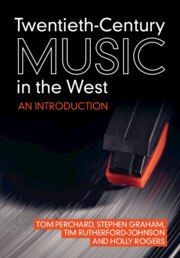Book contents
- Twentieth-Century Music in the West
- Twentieth-Century Music in the West
- Copyright page
- Contents
- Figures
- Tables
- Acknowledgements
- Introduction
- Part I Histories
- Part II Techniques and Technologies
- Part III Mediation
- 9 Recording and Production
- 10 Copyright and the Music Industry
- 11 States and Markets
- 12 Music and the Moving Image
- Part IV Identities
- Bibliography
- Index
12 - Music and the Moving Image
from Part III - Mediation
Published online by Cambridge University Press: 15 September 2022
- Twentieth-Century Music in the West
- Twentieth-Century Music in the West
- Copyright page
- Contents
- Figures
- Tables
- Acknowledgements
- Introduction
- Part I Histories
- Part II Techniques and Technologies
- Part III Mediation
- 9 Recording and Production
- 10 Copyright and the Music Industry
- 11 States and Markets
- 12 Music and the Moving Image
- Part IV Identities
- Bibliography
- Index
Summary
The first public screening of projected moving images by the Lumière Brothers in Paris in 1895 marked the beginning of an artistic revolution. Almost immediately, music became an integral part of the film industry, first being performed live to silent film screenings before becoming fully integrated into the cinematic apparatus on the advent of sound film. While the placement of music against the moving image for commercial film built on centuries of dramatic practice, it also developed forms of audiovisual communication unique to the twentieth century. In fact, we can say that moving-image art is a form exclusive to modern life. As the decades passed, many of the audiovisual conventions established in early film practice began to be appropriated by other moving-image genres, from television (1950s) and music video (1980s) to the interactive forms of video art (1960s), gaming (1970s) and online culture (1990s). These new audiovisual textures were also used by composers and artists to refresh the processes of music composition, while screen media quickly became an integral part of live music performance, from opera to stadium rock.
- Type
- Chapter
- Information
- Twentieth-Century Music in the WestAn Introduction, pp. 295 - 318Publisher: Cambridge University PressPrint publication year: 2022
- 1
- Cited by

